Researchers' Diaries
Lexie Walker
PhD student (Polychaetes) of Australian Museum
Lexie Walker: PhD student of Australian Museum, Sydney, New South Wales
Searching for Polychaetes in the Kimberley Islands
It’s my first trip to the west coast and Kimberley Islands. First impressions ... the west coast is different to the east: the water is blue not green; the land is VERY FLAT, not a mountain in sight; the earth is red; the tidal range is greater by 9 x than most of the east coast ...and there are way less people. My mission was to find polychaetes on the intertidal island reefs and maybe some that have never been found before. At first glance..... in this incessantly dynamic environment where the surface coral is worn smooth, the algae is blown over like trees on a windy mountain and the pools are filled with soft silty mobile sediments... I wondered “where will I find a polychaete??” That’s polychaete (marine bristle worm) NOT parakeet!
Where were the polychaetes? Sitting quietly, while the tide is out, you can see in the remaining pools of water the bright blue, yellow, purple or red spiralled fans of Christmas Tree Worms (Family Serpulidae) ...until some tiny movement shocks them and they disappear to the safety of their hard tube embedded in the coral. A spiny plate (operculum) hidden within the fan, plugs the tube ensuring that nothing can get in and precious moisture inside the tube can’t evaporate while the tide is out. Deeper down in shady caverns Fan Worms (Family Sabellidae) retreat to their soft tubes and the feeding tentacles of terebellids (Family Terebellidae) ooze out over the bottom of the pool. A colleague turning large stones finds a carnivorous Fireworm (Family Amphinomidae) slowly rasping and crushing its sponge prey. Don’t touch though – toxic spines. Breaking off a small piece of the fragile coral reveals long slimy scavenging eunicids (Family Eunicidae) with their multiple sharp jaws and fast moving nereids (Family Nereididae) cleaning up small crabs, microcrustacea, other polychaetes and anything else that didn’t survive the last tidal movement. The eunicids and nereids rapidly move back into the caverns and hollows within the dead coral skeleton that are the hiding places of even more of these cryptic animals, safely taking shelter from the desiccating heat in any place that can provide shade and moisture. Most exciting for me was finding colonies of tiny Polydorella (Family Spionidae) on their sponge hosts. A colony is noticed because of the hundreds of tiny tubes scattered over the surface of the sponge. Each inpidual is only 1-2mm in length and just visible to the naked eye. Paired feeding palps emerge from the tube and glean the surface of the host sponge for suitable foods. Worldwide there are only 5 known species and the current belief is that they only live on sponges. And even better was a colleague (Dr. Monika Schlacher) finding a Polydorella colony on a previously unknown host ... soft coral... a discovery new to science. Team work!!
So... by the end of the trip I had found polychaetes in the Kimberley islands, and there were plenty of them.... just hidden. The collection is currently being sent to experts in museums around Australia for identification. We expect to find many new species, increasing our knowledge of marine biopersity in Western Australia and giving us a better understanding of our natural heritage and that which we hope to pass on to future generations.
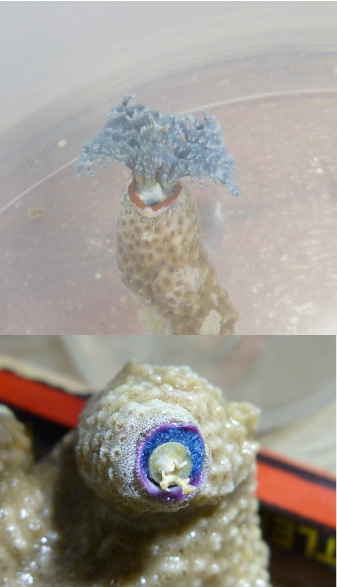
- Christmas Tree Worm
- Image 1
- Copyright Western Australian Museum
Image 1: A Christmas Tree Worm (Family Serpulidae) with tube embedded in coral. Top, fan with two spirals is open, and below, same animal with fan retracted into the tube, clearly showing the spines on the operculum.

- Christmas Tree Worm
- Image 2
- Copyright Western Australian Museum
Image 2: Christmas Tree Worm extracted from the tube. The operculum with gathered debris (left) and the single spiral fan of white, purple and yellow bands are usually the only parts of the animal projecting from the tube. The rest of the body (thorax and abdomen) remains within the tube. This is a different genus to the worm in Image 1.
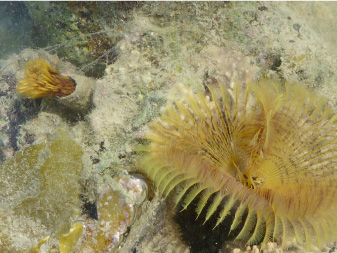
- Sabellidae
- Image 3
- Copyright Western Australian Museum
Image 3: Fan Worms (Family Sabellidae): two Fan Worms, one retreating into its soft tube. The fan is the feeding structure at the head of the animal...the rest of the body is inside the tube.
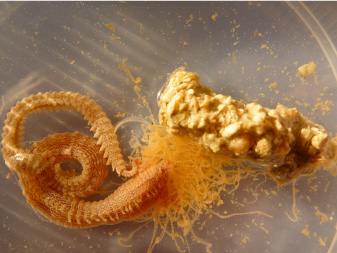
- Terebellidae
- Image 4
- Copyright Western Australian Museum
Image 4: A terebellid (Family Terebellidae) and its soft tube. The mass of fine banded feeding tentacles are bunched around the animals head. These tentacles can be extended across the bottom sands a considerable distance to collect food.
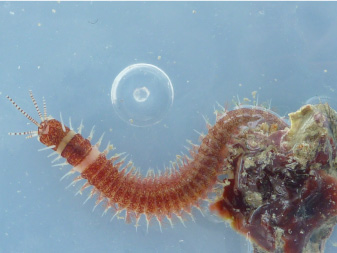
- Eunicidae
- Image: 5
- Copyright Western Australian Museum
Image 5: This eunicid (Family Eunicidae) was very common winding its way through holes in dead coral. Head is to the left with banded tentacles and palps. Fine paired branchiae are just visible at the sides of each segment. The bubble in the middle is 5mm wide.
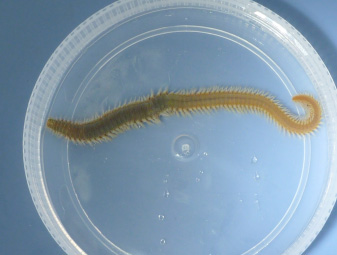
- Amphinomidae
- Image 6
- Copyright Western Australian Museum
Image 6: Beautiful but dangerous, the Fireworm (Family Amphinomidae) stretches across this 15cm wide lid.
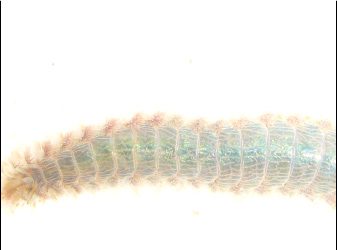
- Polychaetes
- Image 7
- Copyright Western Australian Museum
Image 7: Below, the shimmering iridescent skin of this Fireworm is a feature common to many polychaetes. The pink tufts along the sides of the animal are its branchiae. Head to the left in both.
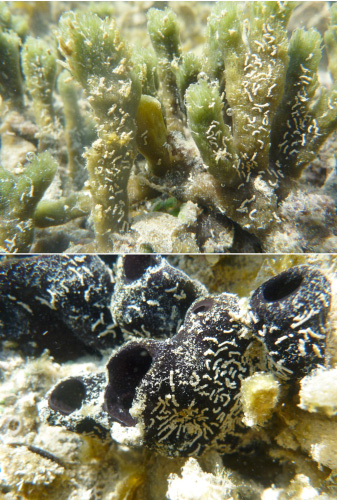
- Polydorella
- Image 8
- Copyright Western Australian Museum
Image 8: Polydorella colonies on different sponges. Research currently in progress will determine if the associations between sponge and worm are species specific.
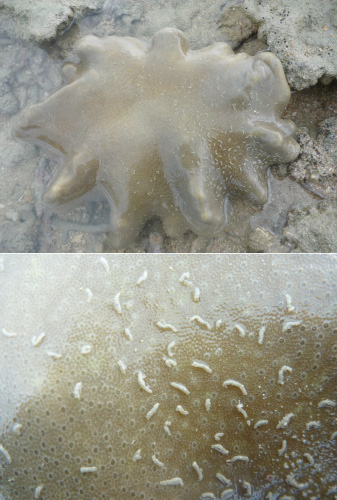
- Polydorella
- Image 9
- Copyright Western Australian Museum
Image 9: The small white tubes of a Polydorella colony on a soft coral. Below, each white tube holds at least one inpidual












